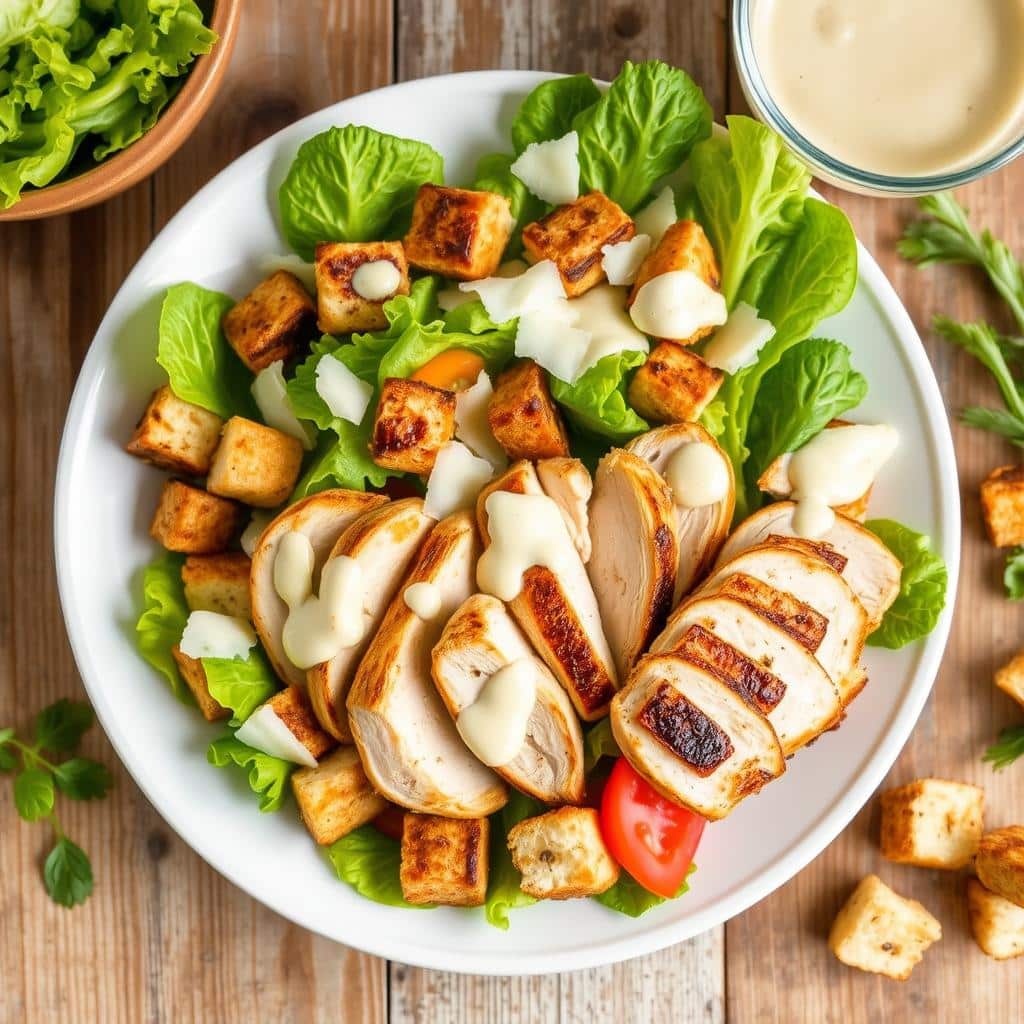I love the crisp taste of a classic chicken Caesar salad. I’ve always wondered about its calories. Knowing the calories in your favorite salad is key, whether you’re watching your diet or just want to make better choices.
In this guide, we’ll explore the chicken Caesar salad in detail. We’ll look at its main parts, traditional recipes, and new twists. By understanding the calories in each ingredient, you’ll see how this salad can work with your diet.
Key Takeaways
- Chicken Caesar salad is a popular and versatile dish, but its calorie content can vary significantly.
- The key ingredients, such as romaine lettuce, grilled chicken, and Caesar dressing, all contribute to the overall calorie count.
- Understanding the nutritional profile of each component can help you make healthier choices when preparing or ordering a chicken Caesar salad.
- Homemade versions often have fewer calories than restaurant-prepared salads, but portion size is still an important factor to consider.
- Making simple substitutions and adjustments can transform a traditional chicken Caesar salad into a more nutritious and calorie-conscious option.
Understanding Chicken Caesar Salad Components
To understand the calories in a chicken Caesar salad, we need to look at its main parts. This classic salad has crisp romaine lettuce, grilled or roasted chicken, and savory Parmesan cheese. It also has crunchy croutons and a creamy Caesar dressing. Knowing the traditional and modern versions helps us see how many calories it has.
Essential Ingredients Overview
The key parts of a chicken Caesar salad are:
- Romaine lettuce – It’s a nutrient-rich base, with romaine lettuce calories being 8 to 10 per cup.
- Grilled chicken – It’s a lean protein, with calories depending on how it’s cooked and how much you eat.
- Parmesan cheese – It adds a rich flavor, with parmesan cheese nutrition giving about 110 calories per ounce.
- Croutons – They add a nice crunch, with croutons calories being 50 to 80 per quarter cup.
- Caesar dressing – This creamy, garlicky dressing greatly affects the salad’s calorie count.
Traditional Recipe Elements
The classic chicken Caesar salad recipe combines these ingredients. The dressing is key for flavor and calories. Traditional Caesar dressings use mayonnaise, Parmesan, anchovies, garlic, and lemon juice for a rich taste.
Modern Variations and Additions
Recently, chefs and home cooks have made new versions of the chicken Caesar salad. They add things like grilled or roasted veggies, bacon, avocado, or hard-boiled eggs. These changes can change the salad’s calorie count and what nutrients it has.

Chicken Caesar Salad Calories: Breaking Down the Numbers
The number of calories in a chicken Caesar salad can change a lot. This depends on how much you eat and how it’s made. Knowing the calorie count is key for good diet choices.
A big chicken Caesar salad from a restaurant can have 400 to 800 calories. This is because of the grilled chicken, Romaine lettuce, creamy dressing, and croutons. A smaller salad with 4-ounce chicken, 2 cups of lettuce, and 2 tablespoons of dressing has about 350 calories.
For how many calories are in a cesar salad with chicken?, the answer is 400 to 800 calories. The higher number is for bigger, restaurant-sized salads. A chicken caesar salad bowl can have 500 to 900 calories, depending on size and toppings.
| Salad Component | Calories per Serving |
|---|---|
| 4 oz Grilled Chicken Breast | 160 calories |
| 2 cups Romaine Lettuce | 16 calories |
| 2 tbsp Caesar Dressing | 180 calories |
| 1/2 cup Croutons | 80 calories |
Making your own chicken Caesar salad can be much lower in calories. You can control the ingredients and how much you eat. Using less dressing, choosing leaner proteins, and watching toppings can help keep calories down.

The calorie count of a chicken Caesar salad really depends on the ingredients and how much you eat. Knowing this can help you make better choices. You can still enjoy this classic dish while keeping your diet balanced.
Nutritional Analysis of Key Ingredients
The classic chicken Caesar salad is all about the ingredients. Let’s look at what makes up this tasty dish.
Romaine Lettuce Nutritional Value
Romaine lettuce is the base of the Caesar salad. It’s packed with vitamins and minerals. A cup of chopped lettuce has just 8 calories. It’s also full of vitamin A, vitamin K, and folate, which are good for you.
Grilled Chicken Protein Content
Adding grilled chicken to the salad boosts the protein. A 4-ounce chicken breast has about 26 grams of protein and 142 calories. This keeps you full and makes the salad a nutritious meal.
Caesar Dressing Composition
The Caesar dressing is a key part of the salad. It’s made with olive oil, Parmesan cheese, garlic, lemon juice, and egg yolks. While tasty, these ingredients add a lot of calories, fat, and sodium.
| Ingredient | Calories (per 2 tbsp serving) | Fat (grams) | Sodium (milligrams) |
|---|---|---|---|
| Caesar Dressing | 130 | 14 | 390 |
| Grilled Chicken Breast | 142 | 3.1 | 73 |
| Romaine Lettuce (1 cup) | 8 | 0.1 | 6 |
Knowing the nutritional values of these ingredients helps you make a healthier Caesar salad. You can choose to use less dressing or leaner chicken to cut down on calories.
Restaurant vs. Homemade Calorie Comparison
When you think about how many calories is an average restaurant caesar salad, there’s a big difference. A restaurant Caesar salad and a homemade one have different calorie counts. Knowing why can help you choose better when you eat out.
Restaurant Caesar salads often have more calories because of their dressings. These dressings are richer, with more oil, egg yolks, and Parmesan cheese. This makes them taste great but adds a lot of calories. Homemade Caesar dressings, on the other hand, can be made with lighter ingredients. You can use Greek yogurt or low-fat mayonnaise without losing flavor.
| Meal | Calories | Fat (g) | Carbs (g) | Protein (g) |
|---|---|---|---|---|
| Restaurant Caesar Salad | 800-1,200 | 50-80 | 20-30 | 30-40 |
| Homemade Caesar Salad | 400-600 | 25-35 | 10-15 | 35-45 |
Restaurants also add a lot of high-calorie ingredients like croutons, Parmesan cheese, and crispy chicken. These make their salads more indulgent. By choosing leaner protein and being careful with toppings, you can make a healthier Caesar salad at home.
The average restaurant Caesar salad can have up to 1,200 calories. But, a homemade version can have as few as 400 calories. By knowing the calorie differences, you can enjoy a Caesar salad without feeling guilty.
Impact of Portion Sizes on Calorie Content
The size of your chicken Caesar salad can greatly affect its calorie count. Knowing the right serving sizes and how they compare to restaurant portions is key. This helps you manage your salad’s nutritional value.
Standard Serving Guidelines
The USDA says a standard salad serving is about 1-1/2 cups of greens. For a chicken Caesar salad, this means:
- 1-1/2 cups of romaine lettuce
- 3-4 ounces of grilled or roasted chicken breast
- 2-3 tablespoons of Caesar dressing
- A small amount of croutons and Parmesan cheese
Restaurant Portion Analysis
Be aware that restaurant salads are often much bigger than what’s recommended. A typical restaurant salad can have 2-3 times more lettuce, chicken, and dressing. This can make the calorie count go over 600-800 calories or more.
Meal Prep Portioning Tips
When making your own chicken Caesar salad, you can control the portion sizes and calories. Here are some tips:
- Measure the lettuce, chicken, and dressing with cups or a digital scale.
- Use less Caesar dressing, as it’s high in calories.
- Choose grilled or roasted chicken for a leaner option.
- Don’t overdo it with croutons and Parmesan cheese to keep calories down.
By paying attention to portion sizes, whether eating out or at home, you can enjoy a healthy chicken Caesar salad. It will meet your health and wellness goals.
Healthier Alternatives and Modifications
Want to make your chicken Caesar salad healthier? Try these tips to turn it into a guilt-free treat.
Swap the Dressing
The classic Caesar dressing is high in calories. Choose a lighter salad dressing instead. It will let the fresh tastes of your greens and protein shine.
Rethink the Croutons
Croutons can add too many carbs and calories. Try using crunchy, low-calorie toppings like toasted nuts, roasted chickpeas, or baked kale chips instead.
Enhance with Healthy Toppings
- Add low-calorie salad toppings like cherry tomatoes, sliced cucumbers, and shredded carrots.
- Top it with healthy salad toppings like sunflower seeds, avocado slices, or feta cheese.
Lighten Up the Protein
Don’t just stick to grilled chicken. Try grilled shrimp or roasted tofu for more nutrition in your salad.
“By making a few simple swaps, you can enjoy a delicious and satisfying chicken Caesar salad that’s lower in calories and packed with wholesome ingredients.”
For a healthier chicken Caesar salad, balance flavor and nutrition. Try these tips to make a low-calorie salad that’s good for you and tastes great.
Making Your Caesar Salad More Nutritious
Chicken Caesar salad is a classic, but you can make it healthier. A few tweaks can boost its health benefits without losing flavor. Let’s look at ways to make your Caesar salad more wholesome.
Light Dressing Options
The traditional Caesar dressing is high in calories and fat. Try using a yogurt-based or vinaigrette dressing instead. These options are creamy and tangy but have fewer calories and less fat.
Protein Alternatives
Grilled chicken is common in Caesar salads, but you can try other proteins. Healthy salad toppings like grilled salmon, roasted tofu, or hard-boiled eggs are nutritious. They add protein without sacrificing taste.
Smart Topping Choices
The toppings you choose greatly affect your salad’s nutrition. Instead of croutons, try healthy salad toppings like roasted chickpeas, sliced almonds, or sunflower seeds. They add crunch without extra calories.
With these simple changes, your Caesar salad can be healthier and still delicious. Try different dressings, proteins, and toppings to find your favorite combination.
Common Mistakes That Increase Calories
Many people think salads are always healthy. But, some common mistakes can make a chicken Caesar salad very high in calories.
Caesar dressing is often the main culprit. It’s full of unhealthy fats like mayonnaise or oil. Using too much dressing also adds a lot of calories.
- Try a lighter Caesar dressing, like one made with yogurt or olive oil and lemon juice.
- Use just enough dressing to lightly coat the greens, not drown them.
Adding too many toppings or croutons is another mistake. They can add a lot of calories.
- Choose grilled or roasted chicken instead of fried or breaded.
- Use whole-grain or low-calorie croutons, or skip them.
- Add more veggies like tomatoes, cucumbers, or bell peppers for extra nutrition.
By avoiding these mistakes, you can enjoy a tasty chicken Caesar salad without feeling guilty. Focus on using quality ingredients and controlling portion sizes.
| Ingredient | Calories in Traditional Version | Calories in Healthier Version |
|---|---|---|
| Caesar Dressing | 150 calories per 2 tbsp | 50 calories per 2 tbsp (yogurt-based) |
| Croutons | 100 calories per 1/4 cup | 30 calories per 1/4 cup (whole-grain) |
| Fried Chicken | 200 calories per 4 oz | 150 calories per 4 oz (grilled) |
Conclusion
The calories in a chicken Caesar salad can change a lot. This depends on the ingredients, how much you eat, and how it’s made. This dish can be both healthy and tasty, but it’s key to watch the calories and choose wisely for your health.
Knowing the calories in each part, like lettuce, chicken, and dressing, helps you make a better salad. Pick lighter dressings, lean proteins, and lots of veggies. This way, you get more nutrition from your meal.
To enjoy a chicken caesar salad calories without losing health, balance is key. Watch your portion sizes and pick your ingredients carefully. Enjoying each bite mindfully lets you enjoy this favorite dish while keeping up with your caesar salad nutrition goals.
FAQ
How many calories are in a typical chicken Caesar salad?
A typical chicken Caesar salad can have a lot of calories. It depends on how big the salad is and what’s in it. A big one from a restaurant might have 500 to 1,000 calories. A homemade one might have 400 to 700 calories, depending on the dressing and toppings.
What is the nutritional breakdown of a chicken Caesar salad?
A chicken Caesar salad has romaine lettuce, chicken, Parmesan cheese, croutons, and Caesar dressing. The calories, fat, and carbs can vary a lot. It’s a good source of protein from the chicken and vitamins from the lettuce. But, the Caesar dressing and croutons can make it high in calories and fat.
Why are some chicken Caesar salads so high in calories?
There are a few reasons why some chicken Caesar salads are high in calories.
1. Too much dressing: Caesar dressing is high in calories because it has oil, eggs, and Parmesan cheese.
2. Big portions: Restaurants often serve big salads that can have over 1,000 calories.
3. Extra toppings: Toppings like bacon, fried croutons, or creamy dressings add more calories.
4. Cooking methods: Frying the chicken instead of grilling can also increase the calorie count.
How can I make a healthier chicken Caesar salad?
To make a healthier chicken Caesar salad, try these tips:
1. Use a lighter Caesar dressing or make your own with Greek yogurt, lemon juice, and Parmesan.
2. Choose grilled or roasted chicken instead of fried or breaded chicken.
3. Use baked or air-fried croutons instead of fried ones.
4. Add fresh, crunchy veggies like romaine lettuce, tomatoes, and cucumbers.
5. Use less Parmesan cheese or just a light sprinkle.
6. Watch your portion sizes and aim for a balanced meal.
How many calories are in a chicken Caesar salad from a restaurant?
A chicken Caesar salad from a restaurant usually has more calories than a homemade one. It can have 500 to 1,000 calories or more. This depends on the size, dressing, and toppings. Always check the nutritional info when you order.

